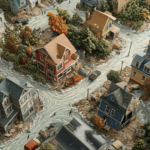Geologist Erin Argyilan’s concept of sand dunes was shattered last July when she heard the parents of a 6-year-old boy frantically shouting that their son had been buried alive after falling into a hole.
Argyilan initially thought Nathan Woessner’s parents must have simply lost sight of him on Mount Baldy at the Indiana Dunes National Lakeshore along Lake Michigan, which draws thousands of visitors annually.
“All of my scientific knowledge was leading me to the conclusion that it couldn’t happen,” said Argyilan, head of Indiana University Northwest’s department of geosciences, who was conducting a wind study that day. “… sand dunes are typically dry individual grains of sand, so they stack rather tightly on top of each other. You don’t expect for there to be large cavities.”
Woessner, of Sterling, Illinois, was rescued after more than three hours and recovered after a couple weeks of hospitalization.
Since July 12, three more holes a foot or less in diameter have been discovered on the 126-foot dune – each lasting a day or less before vanishing – and people have reported seeing holes in the past. Now, officials at parks in Michigan, Oregon, Wisconsin and other states are paying close attention to what Argyilan and three other investigators find, hoping to ensure their own sandy attractions are safe.
“The anomaly that swallowed up that youngster last year was newsworthy because it so rare,” Michigan Department of Environmental Quality spokesman Brad Wurfel said.
Mount Baldy is the only rapidly moving dune at the national lakeshore that people were allowed to walk on, which has caused the dune to move 10 to 20 feet a year in the past decade as vegetation is destroyed, park spokesman Bruce Rowe said.
There is a working hypothesis of the cause of Mount Baldy’s holes: Trees, brush or other structures and debris buried by the dune during the late 1900s became unstable last spring because of wet conditions and collapsed, creating the openings. A ground-penetrating radar survey done last year by the Environmental Protection Agency found 66 anomalous spots beneath the dune, the National Park Service has said.
But the mysterious holes aren’t limited to Indiana. At the Oregon Dunes National Recreation Area in far western Oregon, Deputy District Ranger Carl Bauer said he was aware of reports of sand collapsing where trees had rotted out.
Dina Pavlis, who gives guided tours of the recreation area, reports regularly seeing what she calls “tree holes” and has fallen into several up to her knees. She says they are always in places where remnants of the outline of a tree can be seen in the sand or pieces of old trees are sticking up nearby.
“We’re not really sure what causes the outer part of the sand to stay in place while the inner part disappears. I’m not sure if it’s some interaction between the bark and the sand that causes it to harden just enough or if there’s roots in the sand and that’s holding them in place,” Pavlis said.
Argyilan thinks the same thing may be occurring at Mount Baldy – where she has been mapping the locations of trees and holes – but more investigations are needed.
State and federal parks workers in Michigan have been watching for signs of similar hazards, but the sheer breadth of the state’s dunes, which encompass more than 300,000 acres along hundreds of miles, make systematic inspection impractical. Other dunes along Lake Michigan, such as those in Wisconsin state parks, are smaller and tend to remain in place because of vegetative cover.
Another study is planned at Mount Baldy in August, where G. William Monaghan, a senior research scientist at the Indiana Geological Survey at Indiana University, will use more advanced ground-penetrating radar and take core samples under the dune’s surface to see what lies beneath. He also will use an unmanned aircraft armed with a laser device that can measure the slightest changes in topography.
Mount Baldy will remain closed until scientists can say for sure what is going on and make sure people are safe.
“We can’t even say when the dune will open or, to be honest, if it will ever open,” Rowe said. “Until we have some answers, we can’t really say.”
____
Associated Press writers John Flesher in Traverse City, Michigan, and Todd Richmond in Madison, Wisconsin, contributed to this report.
Was this article valuable?
Here are more articles you may enjoy.

 Insurers Have Paid $12B in Claims for LA Wildfires, Report Shows
Insurers Have Paid $12B in Claims for LA Wildfires, Report Shows  AAA Study Shows Consuming Cannabis and Driving The Same Day is Common
AAA Study Shows Consuming Cannabis and Driving The Same Day is Common  Verisk: Claims Volume Rose 36% in 2024, Largely on Catastrophe Claims
Verisk: Claims Volume Rose 36% in 2024, Largely on Catastrophe Claims  Ex-Deutsche Bank Manager Suing for $165 Million Is Schiraldi
Ex-Deutsche Bank Manager Suing for $165 Million Is Schiraldi 